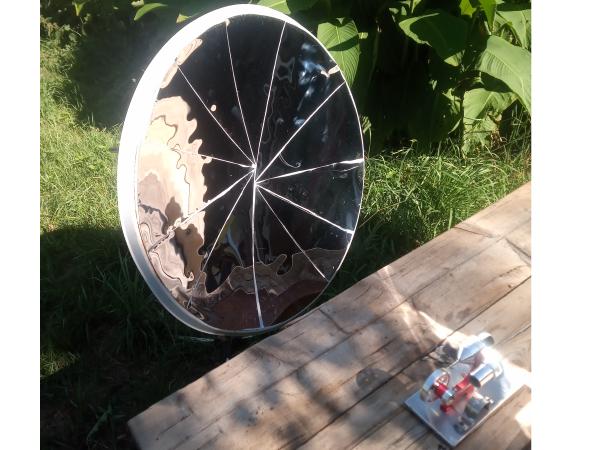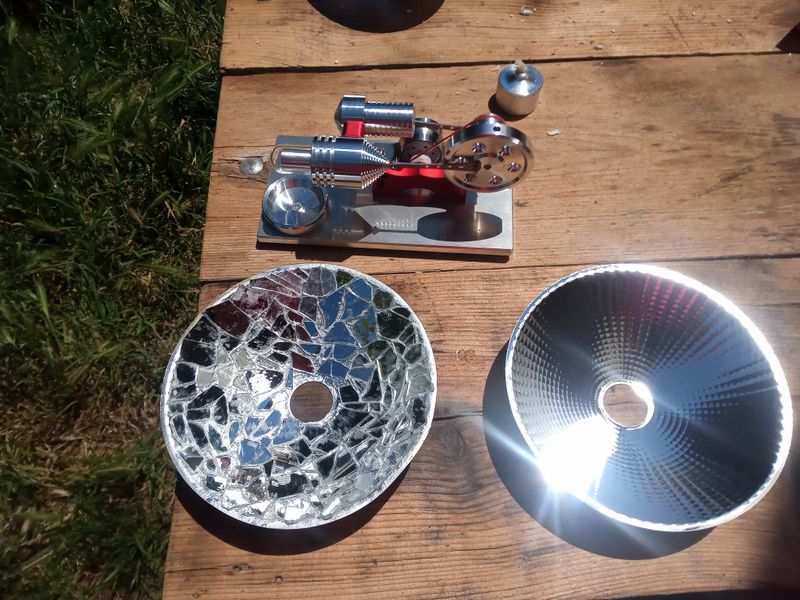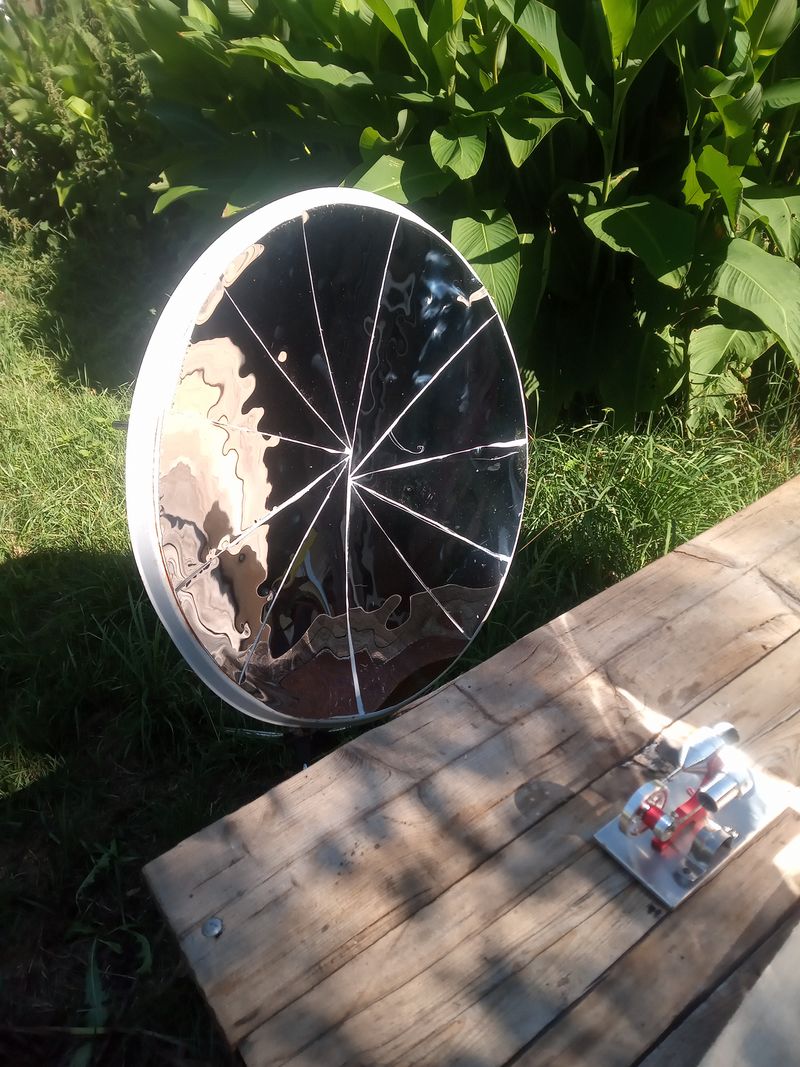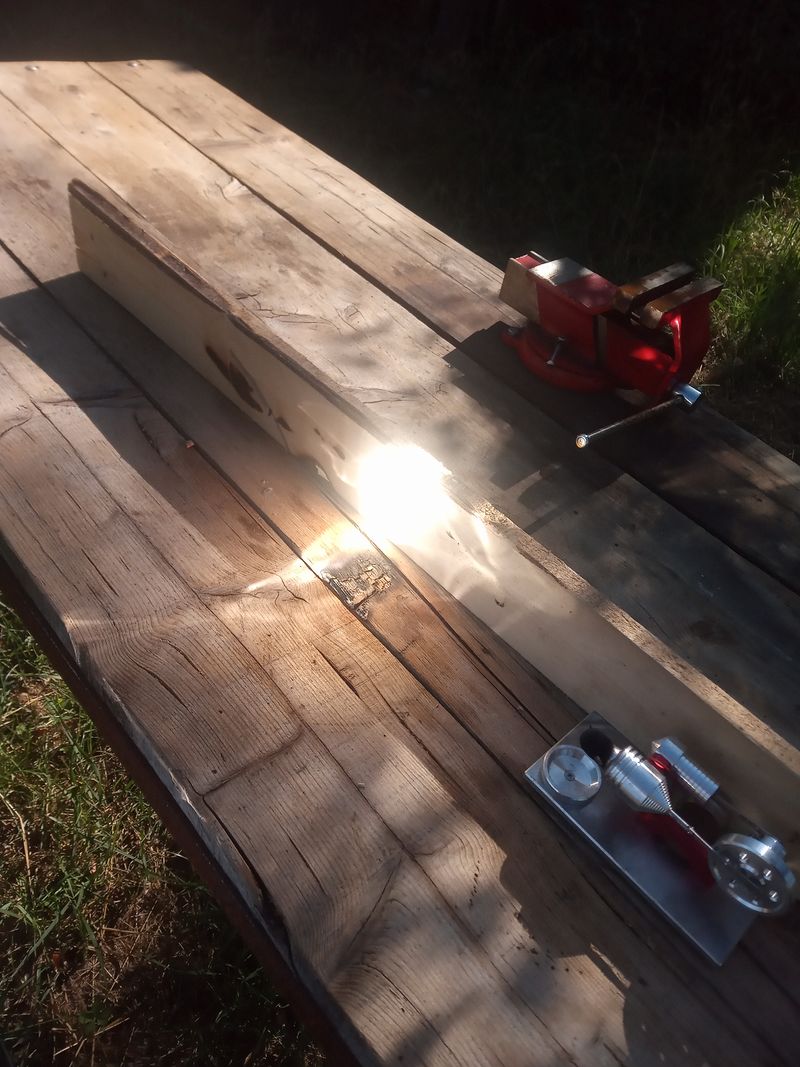Description
Things about stirling engines
Sommaire
Sommaire
Introduction
We now liv in a post-covid world, and wether you're part of
thos who think billionaires tak very seriously climat chang and want
to adress the question with population "regulation" and with survivalists bunkers,
or wether you'r part of those who think billionaires don't car and want
just keep on getting richer and richer until the last drop of petrol,
it becomes urgent to find alternatives to facism and to the models we are offered,
and it includes technical alternatives.
Stirling engine was invented in the XIX century, before combustion engine
and there are a few "mainstream" industrial uses, in particular in the 60s-70s
(Ford Torino,American ship Caloric).
Also called "hot air engin", its principl is to mov hot air alternatively from 1
cold zon to 1 hot zon and gather the mecanic forc produced by air dilatation (special dedicace Bruno Lemair)
and by air contraction.
Performant Stirling engines have necessited a lot of research and development and have achieved yields
more performant than combustion engines (around 40%).
They ar reliabl, silent, and hav high yields.
They ar however better adapted to regular regimes.
chronicl of a sleepless night before going handout leaflet against facsism in order to take advantage of the 24h after reception and
befor sabotag of the "toy" I hav received.Étape 1 - web literature review
W hereby list a few videos of diy stirling engine
mor or less diy and in french languag
W can find engin mad with a coca cola can (DDM Brico Voyageur <nowiki>https://www.youtube.com/watch?v=nBxKOkYx2rI), wooden engine
made with glass syringes for the pistons (Incroyables Experiences https://www.youtube.com/watch?v=s79odgWz6BM) , a 125 cm3 manufactured engine with an estimated power of 0,8kW to 8kW (0,6 horsepower to 6 horsepower) considered the measurement of 800 rpm and a tray mass estimated between 100g and 1kg (French Stirling Fablab https://www.youtube.com/watch?v=Z24dZ3St_JE from series https://www.youtube.com/playlist?list=PLE1TyIvCXNyjlvWRi10LUsEMXKyRS6Ltx on channel https://www.youtube.com/@FrenchStirlingFablab)
You can find notably resources to try to build
your own stirling engin that you won't find in th text below
As a bonus, for teachers, 1 example of a tractor and cran toys build in meccano here:
Étape 2 - Toy power
W will now try to measur th power of stirling engin called "scientific toys"
that we can find on aliexpress or on resselers like scienc labs
You will find attached two videos showing 1 stirling engin "scientific toy" that run
with heat sourc 1 flamm coming from 1 candl and alcool combustion.
Th engin comes with 1 small container and a wick that has to be filled with alcool that produc 1 power
adapted to the engine (video 1).
In video with the candl (video 2), the candl flam doesnt produc a power adapted
and the engin only runs for a few seconds and then stops and becomes very capricious to restart (a bit aleatory after
a few tries even after cooldown).
Therefor w measur the power of the two flams (video 3 and 4):
tim to boil 10mL of water from 20°C to 100°C
energi=10*80 cal=800*4,184J=3347,2J
tim for alcool lamp flam: 40s to 1min (wether simmering or boiling)
tim for candl: 90 to 120s
"alcool lamp:"
max_power=3347/40=84W
min_power=3347/60=56W
"candl"
max_power=3347/90=37W
min_power=3347/120=28W
To try to measur yields, we fix a mass to the motor (her a broken nut of 5g in video 5)
and w measur tork traction
and angular speed.
Broken nut mass is 5g and is fixed at a distanc of d=3cm of th rotation axis.
Rotation speed measurement with a 25€ tachymeter this tuesday 25 june 2024: th tachymeter works by friction (rubber traction that turns an axis of which rotation speed is measured): th traction happens after half a second to 1 second and displays values between 100 and 500 rpm and makes th engin stops.
Rotation speed measurement with 1 laser tachymeter (video 5): 1400 rpm with 5g broken nut attached at 3cm of axis
Rotation speed measurement with laser tachymeter for engine 2 (video 6): 1000 to 5000 rpm with 5g broken nut attached at 1,6 cm of the axis
Th yields is low, but w must recall this is a toy and not a engin made for performanc. We could however mak th measurement exercis with performant scientific toy (multi cylinders, L rendement est faibl, mais il faut s rappeler qu c'est un jouet et pas un moteur fait pour etr performant. On pourrait cependant prolonger l'exercic avec des jouets moteurs stirling dits "performants" (multi cylindres, vertical mover, etc.). Philips stirling engin can hav yields up to 40%.
Étape 3 - Rotation speed verification with video analysis
To measur angular speed, w will us two softwar: 1 python cod sampl based on opencv, and ffmpeg
python commands:
sudo apt install virtualenv
virtualenv --python=/usr/bin/python3 .
source bin/activate
pip3 install opencv-python
import cv2
import os
def charger_images_video(video_filename, output_folder):
"""
Loads video frames from a file and saves each frame as a JPG image.
Args:
video_filename: The path to the video file.
output_folder: The folder where to save JPG images.
Returns:
A NumPy array containing the video images (3D array: frames, rows, cols).
"""
# Open video with OpenCV
cap = cv2.VideoCapture(video_filename)
#Check successful opening
if not cap.isOpened():
print("Erreur d'ouverture du fichier vidéo:", video_filename)
return None
# Check that the output folder exists, if not create it
if not os.path.exists(output_folder):
os.makedirs(output_folder)
# Empty list to store video frames
images_list = []
frame_number = 0
# Play video frames frame by frame
while True:
ret, frame = cap.read()
# Check image playback
if not ret:
break
# Save each frame as a JPG image
frame_filename = os.path.join(output_folder, f'frame_{frame_number:04d}.jpg')
cv2.imwrite(frame_filename, frame)
# Add image to list
images_list.append(frame)
frame_number += 1
# Close video capture
cap.release()
return images_list
# Example of use
video_filename = '00009.MTS'
output_folder = 'frames'
images_list = charger_images_video(video_filename, output_folder)
commands ffmpeg:
sudo apt install ffmpeg ffmpeg -i 00009.MTS -vf fps=25 output_frame_%04d.png
You can reproduc the measurment with the sourc video fil (link here) and the previous sampl code
Unfortunatly at this stag of experienc, the 25fps video doesnt allow to measur correctly
the angular speed of the engin is too fast et makes blurred images on the video broken down in 25 images per second
Unfortunatly the captation at 60fps or more is expensiv (sony camera or zcam at mor than 1000€ on amazon. the advantag is you hav 14 days to test the camera on get reimbursed if it doesnt fit)
w can find 60fps webcam but after a test (Svpro Full HD 1080P Webcam USB Objectif de Mise au Point Manuelle 4 mm, 30fps/60fps/100fps Caméras de Bureau USB CMOS OV2710 pour Linux Windows Android Mac OS, Plug and Play at 33€ on amazon) this wednesday 26 of june captures at 30fps. And you cant really configure video captation software adequately, see this page for exempl wher ther s no parameters to defin fps:
https://wiki.archlinux.org/title/Webcam_setup
test with zcam e2:
video of 60s at 60fps (in theory 3600 frames) with a bit of therebentin (no more alcool 90° confiscated by the cops): the engin runs but visibly slower than when the container is full of 90° alcool. W verify rotation speed.
Strangely, i hav a messag "process stopped" at frame 273 with python script
and ffmpeg does the job and w obtain half a rotation between two consecutive frames, which means 30 rotations per second, which is indeed 1800 rpm
File availabl here if you want to verify:
Étape 4 - Run the engin with a solar sourc
Making a performant stirling engin requires a lot of research and development (go! for hackers who want to leak phillips archive of th ford torin - yes 60s and 70s is not only great for music-)
In theory, with a 40% yield, it requires a solar receptor of 2,5m2 (approximatively a receptor of 90cm radius) for a motor of 1kW
w will here scal based on the flam power that runs th engin correctly:
60W to 90W
W will first us 1 small reflector on which we will fix bits of broken mirrors (after a fixation test it is dramatically worse than with the initial surc of the reflector) and measur the tim it takes to hav a small quantity of water boil
and w will make a linear scaling for an adapted diameter (the power of the sun is linear of th sunny surfac)
test this sunny tuesday june 2024
6cm radius reflectors on the photo : the reflecting surface is made of "bumps" not necessarily as good as dedicated surfaces that can be bought for example at solar brother (https://www.solarbrother.com/acheter/reflecteur-solaire-adhesif-s-reflect-500/)
When putting the finger at the center of the reflector at noon and pointing at the sun, w hav a sensation near being burned with a lighter after 5s.
Th test for boiling 3mL of water failed, wether becaus the surface is not smooth enough, wether becaus th container makes too much shadow on the reflecotr, wether becaus the reflector is not well enough oriented to the sun or becaus the container is not well placed at the focal converging point of the sun rays
The sunlight is approximately 1000W/m2, and the surfac of the reflecotr around:
3,14*0,06*0,06=0,0113m2
Th power of the reflector is therfor theorically around: 0,0113*1000=11,3W
To get a power of 90W at noon (w can modulate to lower at another time or when the sunlight is lower), it would require a reflector of radius r:
r=√(90/3,14*1000)=√(90/3140)=√(0,02866242)=0,17m
W would therefor need a piec of spher of around 34cm of diameter
Th satelite antemna (said parabolic) retrieved in a recycling shop is around 60cm diameter, which is way too larg, th surfac being linear to th squar of th radius (in first approximation)
W will therefor buy a parbolic antemna of 40cm diameter (not found lower) and fix a solar reflector tape
Test du 12/07 négatif avec parabol d 40cm et réflecteur adhésif: le cylindr du piston est transparent et la chaleur des rayons solaires concentrés n chauff pas bien l cylindr. On peut pas démonter l cylindre pour y mettr dla paill d fer comm dans la vidéo de l'étape 1. Test demain avec collag dfeuill alu. Sinon il faudra trouver un moteur avec un cylindre métal.
La vidéo buggu est n'est pas uploadabl. Retest quand météo numériqu meilleur
Test negatif du 13/07 midi avec papier alu sur le cylindr: régler la parabol sur le cylindr a midi est compliqu, il fzut etr tres précis et avec l materiel qj'ai (un pied de micro) il faut suspendr l moteur en l'air,etc.
Test négatif du 16 juillet 18h: parabol d 40cm, concentration des rayons a peu près satisfaisant, puissanc solair insuffisant
Test négatif du 23 juillet 18h: parabol d 60cm, concentration des rayons solaires trop dispers, puissanc solair insuffisant
Le carr d lumièr concentr est trop dispersé. Il semblerait judicieux d fair un concentrateur plus précis (un véritable bout dsphère).
On essaierai après les vacances d fair un concentrateur sphériqu (donc avec un point focal plus concentr) avec un moul en plâtr sur un spher typ ballon d kin/yoga. Si vous voulez fair l tutoriel pour fair c typ d concentrateur, libr à vous!
Étape 5 - optimiser et fabriquer un recepteur solaire mobile
Là, j vous pass la balon.
D'abord, il faudrait réfléchir à 1 récepteur qui suit l soleil dynamiquement en fonction d sa position dans la journ (du jour et d l'heur) et d la latitud et longitud,
et plus important: qui soit capabl d renvoyer les rayons concentrés sur 1 point fix quel q soit l'heur.
Ensuit, on peut imaginer 1 truc constitu d plusieurs recepteurs d diametres distinct adapté à 1 ensoleillement variabl.
On a alors 1 sourc d'énergi renouvelabl infini et transportabl qui va fonctionner pour 1 ensoleillement avec 1 seuil haut et 1 seuil bas.
On peut mêm aller jusqu'à imaginer 1 sociét dont les machines n tournent pas quand il n'y pas assez ou trop d soleil, mais c'est d la scienc fiction.
Pour donner des points d repères, les plus grands mirroirs non pétés qu'on est actuellement capables d fabriquer sont les mirroirs d téléscop géants d 30m d diametr.
Les mirroirs d téléscopes d 5m à 10m d diametres sont plus courants pour les grands téléscopes.
J n suis pas spécialist du tout, just 1 vulgarisateur préoccupé par l changement climatiqu
et la mont du fascism.
A c titr et à c stad d mon expérimentation, seuls deux aspects "pratiques" m'interrogent pour 1 utilisation courant:
stopper l moteur (il suffit pas d stopper l'injection de carburant)
pour des utilisations longues: garder la sourc froid froid assez longtemps sans surdimensionner la puissanc en entr d la sourc chaud (pour 1 deltaT performant)
Et parc qu'à l'heur du fascim rampant qui mont dans tout la société, il faut arreter d s'auto censurer pour parler d politiqu quand on parl en son nom,
1 gouvernement qui prend au sérieux l changement climatiqu aurait depuis longtemps mis
les moteurs stirling dans les problemes d prépa, incité des consortiums à travailler dessus,
cr des groupes mixtes d'ingénieur.e.s-technicien.e.s-bricoleurs.e.s non diplomé.e.s multi territoriaux pour travailler sur c type d questions!
Les connaissances scientifiqu et techniques sont contextuelles d'époques et c n'est pas q dans le spatial (aller sur la lun)
qu'on a perdu des savoirs faires, si les lobbys empechent d remettr à l'ordr du jour des techniques oubliées
qui ont fait leur preuv, c'est au politique d créer les incitations nécessaires!
Étape 6 - a vous
voilà, vous avez maintenant des ressources web pour fabriquer un moteur stirling, des pistes pour faire des recherches sur les fabricants de moteurs stirlings performants, une methodo pour tester et verifier les vitesses de rotation de moins de 3600 tours/minutes dans un contexte numérique de flicage surveillance et entrave, une idée pour des moteurs à concentration à base de concentrateurs dynamiques.
Pour un algo de suivi du soleil, vous pouvez reprendre du code ici:
Dimensionner et faire un tracker solaire photovolatïque low tech
Cependant, un dispositif à base de 4 celulles photoelectriques et un petit circuit electronique de recherche de maximum par rotation/entrainement d'un moteur pourrait avantageusement remplacer le codage en dur et s'adapter à toutes les latitudes et longitudes.
J'ai aussi le soucis du sabotage des concentrateurs (rayures, reflecteur décollés) assez vite, mais je suis sur que vous trouverez des parades à ça aussi!
Published




 Français
Français English
English Deutsch
Deutsch Español
Español Italiano
Italiano Português
Português